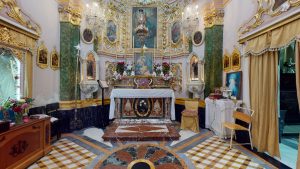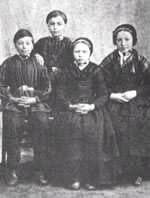
This is a 3D Walk-Through Virtual Tour. To interact, click or tap the screen and 'walk' around.
WELCOME!
to
The Chapel of Our Lady of Good Hope
Click/Tap to View

Built in 1760, this is one of the most beautiful chapels in Mosta. On entering, the visitor is surprised by the beautiful baroque decoration. The paintings include the titular on the main altar and the two flanking artworks, all by Rocco Buhagiar.
Another painting depicting Our Lady of Good Hope is by Raffaele Bonnici Calì, while the titular statue is the work of Gerolamo Dingli.
 The chapel, and the cave under it, are a Marian site that has enjoyed a long-standing devotion. A number of ex-votos can be seen in the sacristy and also in the cave. As this chapel is associated with the legend of a young girl who was protected through divine intervention from falling into slavery at the hands of Barbary corsairs, and is dedicated to the Madonna under the title of Hope of Christians, many sufferers have travelled there to plead for healing.
The chapel, and the cave under it, are a Marian site that has enjoyed a long-standing devotion. A number of ex-votos can be seen in the sacristy and also in the cave. As this chapel is associated with the legend of a young girl who was protected through divine intervention from falling into slavery at the hands of Barbary corsairs, and is dedicated to the Madonna under the title of Hope of Christians, many sufferers have travelled there to plead for healing.
Two life-size models of the Evangelists St. John and St. Luke can be seen in the cave. The sculpture Sebastiano Spampinato carved two marble statues on these models for the Rotunda presbytery after being commissioned by the then rector of Mosta church, Rev. Angelo Camilleri, who paid costs totalling £140.
A marble slab, on one side of the wall, inscribed in Maltese, states that Bishop Mons. Pietro Pace issued a decree on 23rd June, 1914 which conceded a 100 days indulgence to whoever recited a Salve Regina before the statue of Our Lady venerated in this cave. Another episcopal decree of 8th July, 1927, issued by Bishop Mons. Dom Mauro Caruana O.S.B. conceded another 100 days indulgence to whoever said a Holy Father, Hail Mary and Glory be to the Father, before the statue.
wall, inscribed in Maltese, states that Bishop Mons. Pietro Pace issued a decree on 23rd June, 1914 which conceded a 100 days indulgence to whoever recited a Salve Regina before the statue of Our Lady venerated in this cave. Another episcopal decree of 8th July, 1927, issued by Bishop Mons. Dom Mauro Caruana O.S.B. conceded another 100 days indulgence to whoever said a Holy Father, Hail Mary and Glory be to the Father, before the statue.
Video Credit: Andrew Caruana – View on YouTube
Story of Our Lady of Hope
At the time of the apparition Pontmain was a small village, inhabited by simple and hardworking country folk, who were guided by their parish priest Abbé Michel Guérin. The Barbadette family consisted of father César, his wife, Victoire, with their two sons Joseph and Eùgene, aged ten and twelve, and another older boy who was away in the army. On the evening of 17 January 1871, the two boys were helping their father in the barn when the eldest, Eùgene, walked over towards the door to look out.
As he gazed at the star studded sky he noticed one area practically free of stars above a neighbouring house. Suddenly he saw an apparition of a beautiful woman smiling at him; she was wearing a blue gown covered with golden stars, and a black veil under a golden crown.
 As it was now about a quarter past six, and time for supper, the boys were ordered inside but soon after allowed to go outside again. The Lady was still there and so the local schoolteacher, Sister Vitaline, was sent for. She couldn’t see the Lady, and so she went to fetch three young children from the school to see their reactions.
As it was now about a quarter past six, and time for supper, the boys were ordered inside but soon after allowed to go outside again. The Lady was still there and so the local schoolteacher, Sister Vitaline, was sent for. She couldn’t see the Lady, and so she went to fetch three young children from the school to see their reactions.
Immediately as they arrived, two older children, two girls aged nine and eleven, expressed their delight at the apparition, describing it as the boys had done, although the youngest child saw nothing.
The following March a canonical inquiry into the apparition was held, and in May the local bishop questioned the children, the inquiry being continued later in the year with further questioning by theologians and a medical examination. The bishop was satisfied by these investigations, and in February 1872 declared his belief that it was the Blessed Virgin who had appeared to the children.
into the apparition was held, and in May the local bishop questioned the children, the inquiry being continued later in the year with further questioning by theologians and a medical examination. The bishop was satisfied by these investigations, and in February 1872 declared his belief that it was the Blessed Virgin who had appeared to the children.